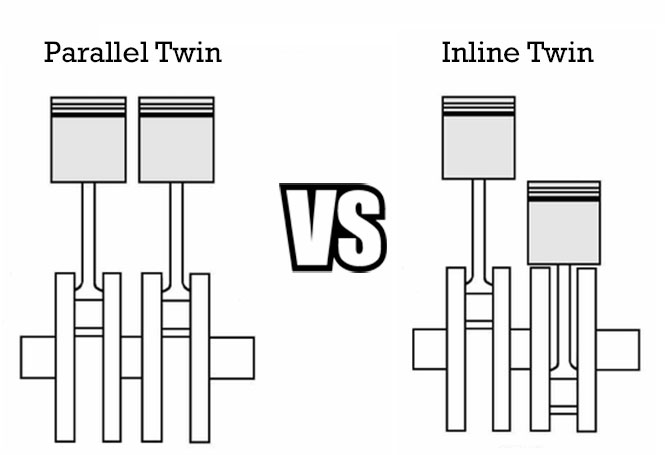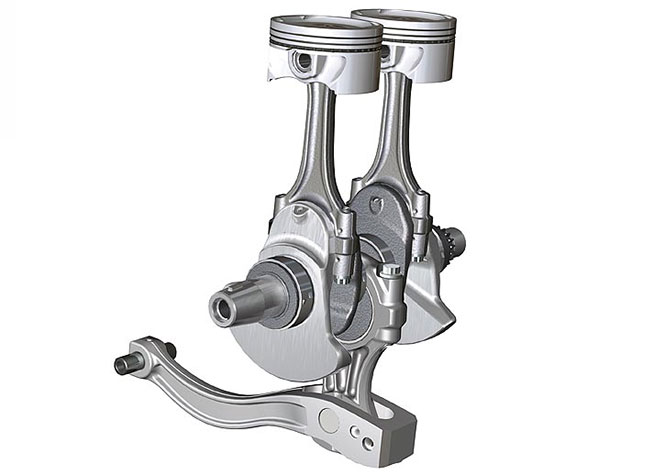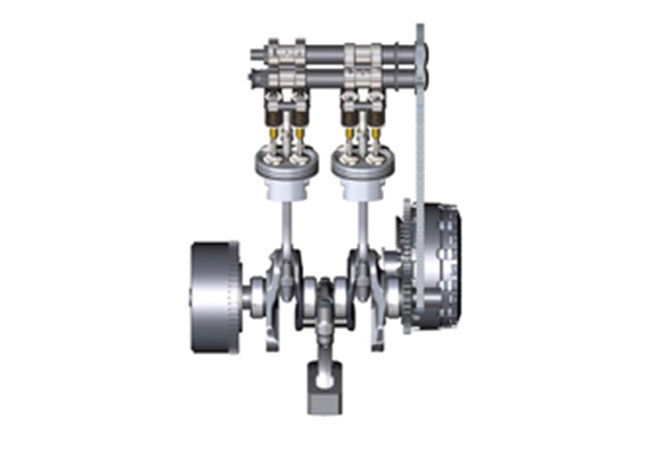Inline Twin Engine vs Parallel Twin Engine
The motorcycle engines which tend to use in excess are the engines having two cylinder instituted side by side in mechanism with two pistons connected to a single crankshaft. All these engines as the straight two, parallel twin, inline twin, vertical twin, etc. uses the above mentioned mechanism to evolve the power and can put under a broader category- Straight Twin engine.

Basically, The Inline Twin & Parallel Twin are referred as a synonym, but both differ fundamentally. If the Straight Twin engine is taken as base for the Inline Twin and Parallel Twin and then differentiate them on the root of their placement position on the frame, pros & cons and many more. It would be easy to say clearly about the working and performance of the deuce.
See More: 2016 New Ultra-Modern Technologies for Bikes
Inline Twin:
The engine employs the mechanism of two cylinders placed adjacent with two pistons coupled to a single crankshaft. The inline twin engine ideally be placed “In line” with the frame of the motorcycle that means one cylinder put face on with the other kept behind of it. The piston moves alternatively and opposite to each other and the angle of degree for the Inline Twin is 180 degrees. The older version of motorcycles uses this cylinder configuration.

Parallel Twin:
The most common setup of transversely placed cylinders with the frame for a straight twin engine can not define originally the parallel twin engine. The piston movement up and down together and simultaneously parallel in a transverse twin engine defines completely the “Parallel Twin” engine. The Parallel Twin engine’s angle of crankshaft moving is 360 degrees to move the pistons up and down simultaneously.

Read Also: Top 7 Motorcycles Under INR 1 Lakh 2016
Pros and Cons of the Straight Twin engines:
Pros:
- The Straight Twin engines as Inline Twin and Parallel Twin are simpler, easier to manufacture, low maintenance and more cost effective than the Flat Twin or V-Twin engines.
- The 360 degrees parallel twin engine can use single carburetor for both cylinders and no need of a distinct ignition system for each cylinder.
- The inline twin engine with 180 degrees angle of the crankshaft by moving up and down piston cancel out the vibrations
Cons:
- The Straight Twin engines produce much vibrations in comparison to the V-Twin or Flat Twin engines. The torsional torque, which applied to the pistons moving in the opposite direction on 360 degree crankshaft in parallel twin and the irregular firing pulse on 180 degree crankshaft on Inline twin.
- The vibration problem on the 360 degrees parallel twin engines can be reduced by the extra balance shaft and for compact size engines this vibration issue is not more important.
- The inline twin setup engine needs a different fueling system and separate ignition system for both the cylinders.
Inline Twin Engine vs Parallel Twin Engine
https://www.blog.sagmart.com/wp-content/uploads/2016/02/Parallel-twin-vs-inline-twin-300x300.jpg Bikes Reviews and TipsThe motorcycle engines which tend to use in excess are the engines having two cylinder instituted side by side in mechanism with two pistons connected to a single crankshaft. All these engines as the straight two, parallel twin, inline twin, vertical twin, etc. uses the above mentioned mechanism to evolve the power and can put under a broader category- Straight Twin engine.

Basically, The Inline Twin & Parallel Twin are referred as a synonym, but both differ fundamentally. If the Straight Twin engine is taken as base for the Inline Twin and Parallel Twin and then differentiate them on the root of their placement position on the frame, pros & cons and many more. It would be easy to say clearly about the working and performance of the deuce.
See More: 2016 New Ultra-Modern Technologies for Bikes
Inline Twin:
The engine employs the mechanism of two cylinders placed adjacent with two pistons coupled to a single crankshaft. The inline twin engine ideally be placed “In line” with the frame of the motorcycle that means one cylinder put face on with the other kept behind of it. The piston moves alternatively and opposite to each other and the angle of degree for the Inline Twin is 180 degrees. The older version of motorcycles uses this cylinder configuration.

Parallel Twin:
The most common setup of transversely placed cylinders with the frame for a straight twin engine can not define originally the parallel twin engine. The piston movement up and down together and simultaneously parallel in a transverse twin engine defines completely the “Parallel Twin” engine. The Parallel Twin engine’s angle of crankshaft moving is 360 degrees to move the pistons up and down simultaneously.

Read Also: Top 7 Motorcycles Under INR 1 Lakh 2016
Pros and Cons of the Straight Twin engines:
Pros:
- The Straight Twin engines as Inline Twin and Parallel Twin are simpler, easier to manufacture, low maintenance and more cost effective than the Flat Twin or V-Twin engines.
- The 360 degrees parallel twin engine can use single carburetor for both cylinders and no need of a distinct ignition system for each cylinder.
- The inline twin engine with 180 degrees angle of the crankshaft by moving up and down piston cancel out the vibrations
Cons:
- The Straight Twin engines produce much vibrations in comparison to the V-Twin or Flat Twin engines. The torsional torque, which applied to the pistons moving in the opposite direction on 360 degree crankshaft in parallel twin and the irregular firing pulse on 180 degree crankshaft on Inline twin.
- The vibration problem on the 360 degrees parallel twin engines can be reduced by the extra balance shaft and for compact size engines this vibration issue is not more important.
- The inline twin setup engine needs a different fueling system and separate ignition system for both the cylinders.

Article potentially useful, unfortunately it’s written in an unintelligible bad English, so most of the content is difficult to understand.
Can you specify the paragraph?